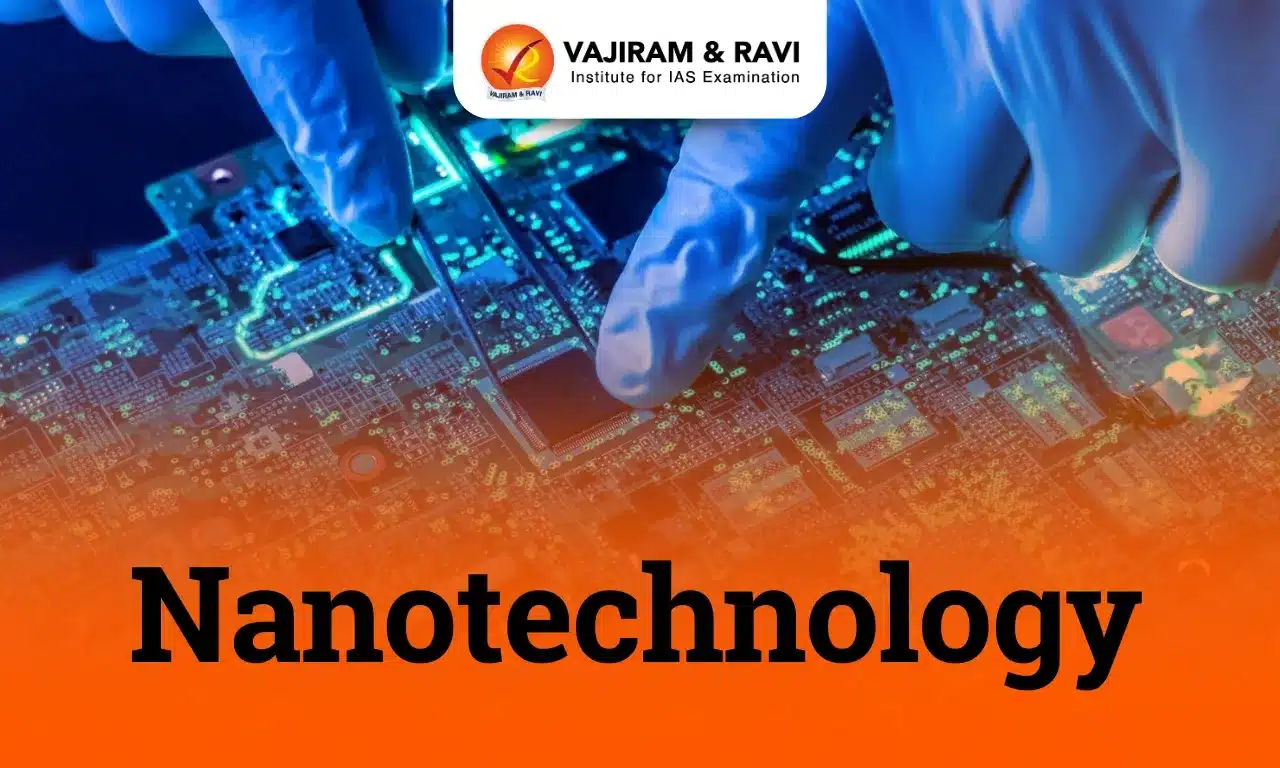Nanotechnology is the study and manipulation of matter at dimensions ranging from 1 to 100 nanometers, where unique phenomena allow for novel applications. Nanomaterials enable lighter, stronger, and more functional materials while nanoelectronics power faster, smaller computing. Nanomedicine is facilitating early diagnosis, smart drug delivery, and regenerative medicine. Nanotech is being integrated into various industries such as food packaging, cosmetics, textiles, chemicals, automotive, aerospace, and agriculture.
Nanotechnology in India is swiftly emerging as a catalyst for transformative advancements across diverse sectors, ranging from medicine to textiles. However, challenges around regulation, environment, and ethical aspects need addressing. India can reap nanotechnology's benefits across sectors to achieve progress in science, economy, and society aligned with the United Nations Sustainable Development Goals.
| Nanotechnology in Medicine | Applications of Nanotechnology in the Manufacturing Industry |
| Nanotechnology in Agriculture | Biotechnology |
What are Nanomaterials?
To be classified as a nanomaterial, a material must have at least one dimension in the nanoscale, which is smaller than 100 nm. The properties of nanomaterials are different from those of micromaterials or bulk materials due to their size and surface effects. Nanomaterials can be organised into several categories based on their composition and characteristics:
| Classification type | Key description |
| Inorganic-Based Nanomaterials |
- These particles are generally non-toxic, hydrophobic, biocompatible, and highly stable. - Examples: Metal and metal oxide nanoparticles - Applications: Biomedicine, catalysis, sensors, etc. |
| Organic-Based Nanomaterials |
- These particles are biocompatible, biodegradable, and non-toxic. - Examples: Liposomes, layered biopolymers, dendrimers, protein aggregates, lipid bodies, milk emulsions - Applications: Drug delivery, cosmetics, food science, etc. |
| Carbon-Based Nanomaterials |
- These particles are known for their low toxicity, high electrical conductivity, flexibility, and optical transparency. - Examples: Graphene, fullerenes, carbon nanotubes - Applications: Electronics, sensing, drug delivery, composites, coatings, etc. |
| Composite-Based Nanomaterials |
- These particles include materials with enhanced properties such as flexibility, high strength, electrical conductivity, heat resistance, and increased barrier properties. - Examples: Carbon nanotube-quantum dot hybrids, graphene-polymer composites - Applications: Sensors, energy storage, structural reinforcement, etc. |
Additional Materials and Properties
- Quasi-One-Dimensional Nanostructures: These are produced from materials like carbon, silicon, and germanium, and conducting metals such as copper.
- These structures offer advantages over traditional materials due to their larger surface area-to-volume ratio, better mechanical strength, higher porosity, and greater functionalisation flexibility.
- Carbon Nanotubes: These include remarkable thermal and electrical conductivity and exceptional tensile strength.
- Carbon nanotubes' potential applications in numerous fields continue to attract significant research attention.
- Quantum Dots: These materials comprise semiconductor nanocrystals with unique properties between discrete molecules and bulk semiconductors.
- Quantum dots have applications in drug delivery, diagnostics, medical imaging, and solar cells.
- Nanocomposites: These are manufactured from two distinct constituents, typically a polymer and an inorganic solid.
- Nanocomposites possess superior properties to those of their components. Some nanocomposites are up to 1,000 times tougher than bulk components.
- Graphene: This has unique properties such as being strong yet flexible, lightweight, and resistant.
- Its versatility makes it applicable in electronics, energy storage, composites, coatings, biomedical devices, sensors, drug delivery, tissue engineering, and more.
- MXenes: These are two-dimensional layered ceramic materials derived from a bulk crystal known as MAX.
- MXenes demonstrate excellent conductivity, volumetric capacitance, and potential uses in energy storage, optoelectronics, and medicine.
- Lipid Nanoparticles: Recently making headlines due to their role in COVID-19 mRNAvaccines as mRNA carriers.
- Lipid nanoparticles have also proven successful in small-molecule delivery in nanomedicine.
Applications of Nanotechnology
Nanotechnology finds various applications across multiple sectors, including:-
| Area | Applications |
| Materials and Processes |
- Durable smart fabrics with nanosensors for medicine, health monitoring etc. - Nanoscale films for self-cleaning windows and eyeglasses. - Nanoscale additives for lightweight armour. - Nanocatalysts to boost chemical reactions. |
| IT and Electronic |
- Nanoscale transistors, magnetic random access memory systems. - Flexible electronics for wearables and medical devices. - Quantum dot TV displays. - Printed electronics. - Improved flash memory and batteries. |
| Biomedicine and Healthcare |
- Gold nanoparticles for targeted gene therapy and cancer treatment. - Advanced imaging and diagnostic tools. - Targeted drug delivery using nanocapsules. - Tissue engineering and regenerative medicine. - Nanoparticle-based vaccines. |
| Energy |
- Nanocatalysts for improved fuel efficiency. - Nanomaterials to optimize combustion and reduce friction. - Carbon nanotube membranes for CO2 capture. - Nanotech-enabled solar panels and batteries. |
| Environmental Remediation |
- Graphene membranes for water purification. - Nanoparticles for cleaning wastewater. - Nanosensors for pollution monitoring. |
| Agriculture and Food Processing | - It includes precision farming and detecting crop diseases, efficient nutrient delivery, controlled release of nutrients and protection from pests, to improve food safety and shelf life, and purification in food processing. |
| Transportation |
- Polymer nanocomposites for lightweight components. - Efficient batteries and temperature control. - Nanosensors and electronics. -Nano-engineered infrastructure materials. |
Challenges and Concerns with Nanotechnology
Nanotechnology poses several challenges and concerns that need to be addressed for its safe and responsible development:
- Toxicology: Nanoparticles can accumulate in various organs and induce toxicity.
- Research has shown that nanoparticles can accumulate in the nasal cavities, lungs, and brains of animals, raising concerns about their potential impact on human health.
- Long-term safety: There are concerns about the long-term safety of nanomaterials due to their potential toxic effects on humans and the environment.
- Studies suggest that nanoparticles can accumulate in the body over time, leading to various health issues.
- Commercialisation: Scaling up nanotechnology for mass production requires significant investment and expertise.
- The transition from lab-scale production to industrial-scale manufacturing poses challenges that need to be carefully addressed
- Availability of resources: While some concerns exist regarding the availability of resources for nanomaterial production, many essential minerals are abundant on Earth.
- However, scaling up production may require careful resource management
- Regulation: The regulatory framework for nanotechnology is still evolving but ongoing developments in the industry necessitate continuous updates to regulations to ensure safety and transparency
- Environmental impact: Nanoparticles' small size allows them to penetrate deep into the environment, raising concerns about their behaviour and potential chemical reactions upon interaction with other particles.
- The lack of comprehensive research into these aspects poses a significant challenge
- Health effects: Inhaled nanoparticles can have adverse health effects, such as lung inflammation and heart problems.
- Understanding how nanoparticles interact with living organisms and their potential long-term health implications is crucial for addressing health concerns related to nanotechnology
- Safety discussion: The discussion around the risks and safety of nanoparticles is essential for ensuring responsible development in nanotechnologies.
- Addressing environmental, health, and safety concerns related to nanoparticles is crucial for their sustainable use.
Nanotechnology in India
India has been actively developing its capabilities in nanotechnology with initiatives aimed at promoting research and translating discoveries into practical applications. Key highlights of India's involvement in nanotechnology include:
- Research and Development: The Jawaharlal Nehru Centre for Advanced Scientific Research (JNCASR) was founded in Bengaluru in 1989, and the Department of Science and Technology (DST) initiated the Nano Science and Technology Initiative (NSTI) in 2001.
- Government Initiatives:
- The Nano Mission was launched in 2007 under the DST, aiming to position India as a global leader in nanoscience research and facilitate the transition of innovations from the laboratory to the market.
- Five Nanoscience Centres were established to coordinate activities in the thematic areas of nanomaterials, nanodevices, and nanosystems.
- The Council of Scientific and Industrial Research initiated the New Millennium Indian Technology Leadership Initiative Programme to integrate nanotechnology developments with industrial applications.
- Industry Linkages and Startups:
- Over 30 companies, including TCS, Bharat Biotech, Sun Pharma, and Tata Chemicals, are engaged in nanotechnology products and applications.
- Nano incubators are strengthening entrepreneurship by providing resources and funding support to technology startups and young researchers with promising ideas and prototypes.
- International Collaborations:
- India has established agreements with countries like the USA, Germany, Italy, Japan, and Israel, and is participating in multilateral projects of UN agencies.
- As of 2023, India ranks third globally in terms of contributions to nanotechnology publications, demonstrating its ongoing commitment to expanding its capacity in this rapidly evolving field.
India’s Achievements in Nanotechnology
India has demonstrated substantial achievements in nanotechnology across various domains, including water, clean energy, defence, health, medicine, infrastructure, communication, and others. Key developments include:
- Advanced Nanomaterials: India has developed specialized nanomaterials such as Nanoshells, NanoSniff Technologies, and Nanophosphor Application Centers.
- Nanoelectronic transistors were fabricated using carbon nanotubes as channels by the IISc Bangalore team as an energy-efficient alternative to silicon-based transistors.
- Logic gates were developed using nanoscale components by the IIT Bombay team that can pave the way for futuristic quantum computers.
- Healthcare: Scientists at IIT Bombay have developed nanotechnology-based drug delivery systems like nanoparticles, nanocapsules, lipid structures etc. that can provide targeted drug delivery and controlled release.
- For example, they designed a curcumin nanoformulation for improved bioavailability.
- Bharat Biotech used bioinformatics, molecular modelling and nanotechnology platforms for accelerated drug discovery to develop India's first indigenous COVID-19 vaccine - Covaxin.
- Defence: Defense applications include lightweight armour, stealth coatings, and explosives detection.
- Water treatment: IIT-Madras researchers fabricated metal nanoparticle-based filters that can remove microplastics, pesticides and heavy metals from water.
- Tata Chemicals has developed a low-cost nanofiltration device called Tata Swach that can purify water without electricity.
- Skilled workforce: The government supports skill development and training to enhance the capabilities of the Indian nanotech ecosystem.
- Collaboration: Partnerships between academia, industry, and government organizations facilitate research and development.
- Foreign engagement: Foreign companies can collaborate with Indian entities, contributing to skill development, technology transfer, and sustainable solutions.
Challenges
Besides offering potential benefits, there are high concerns about the potential challenges associated with nanotechnology in India.
- Quality Research Gaps: India lacks sufficient risk-related research and material characteristic information in nanotechnology applications, affecting progress.
- Financial Constraints: High costs for intellectual property rights and nanotechnology infrastructure, coupled with limited financial resources, impede research and development.
- Low Investment: India's nanotechnology research expenditure is minimal compared to Japan, the US, France, and China.
- Integration and Skilled Manpower: Poor collaboration between labs and industry, and a shortage of skilled individuals bridging technology and commercial sectors, pose challenges.
- Limited Academic Presence: Few students pursue nanotechnology degrees, and career opportunities are scarce.
- India awards significantly fewer PhDs in nanoscience and technology than China and the USA.
- Regulatory challenges: In India, nanotechnology lacks comprehensive regulation due to the absence of a single authority.
- Additionally, existing institutions face capacity constraints, information asymmetry, and a lack of inter-agency coordination, hindering effective risk management.
- Private sector participation: Despite notable innovations, the Indian private sector's limited involvement in nanotechnology research impedes its commercialisation prospects.
Measures Needed
Nanotechnology is still in a nascent stage and has significant potential in the future especially concerning the medical and electronics field. The following measures can be adopted for further improvement of nanotechnology in India.
- Enhanced funding: Increase financial support for nanotechnology R&D to foster innovation and tech advancement.
- Allocating additional resources to research projects focused on nanomedicine, nanoelectronics, and nanosensors.
- Education and training: Offer specialised degree programs and training for researchers and engineers to develop a skilled nanotech workforce.
- Regulatory framework: Develop robust guidelines for safe and ethical nanomaterial use, ensuring environmental and human safety while promoting innovation.
- Establishing standards for nanoparticle toxicity assessment and disposal protocols.
- Public-private partnerships: strengthen collaboration between academia and industry, incentivising private sector participation in nanotech R&D and commercialisation.
- Joint ventures between research institutions and companies to develop nanotechnology-based products.
- Infrastructure development: Invest in state-of-the-art research facilities and labs dedicated to nanoscience and nanotechnology.
- International collaborations: Emphasise partnerships with global institutions to leverage expertise and accelerate technological advancements.
Last updated on November, 2025
→ Check out the latest UPSC Syllabus 2026 here.
→ Join Vajiram & Ravi’s Interview Guidance Programme for expert help to crack your final UPSC stage.
→ UPSC Mains Result 2025 is now out.
→ UPSC Notification 2026 is scheduled to be released on January 14, 2026.
→ UPSC Calendar 2026 is released on 15th May, 2025.
→ The UPSC Vacancy 2025 were released 1129, out of which 979 were for UPSC CSE and remaining 150 are for UPSC IFoS.
→ UPSC Prelims 2026 will be conducted on 24th May, 2026 & UPSC Mains 2026 will be conducted on 21st August 2026.
→ The UPSC Selection Process is of 3 stages-Prelims, Mains and Interview.
→ UPSC Result 2024 is released with latest UPSC Marksheet 2024. Check Now!
→ UPSC Prelims Result 2025 is out now for the CSE held on 25 May 2025.
→ UPSC Toppers List 2024 is released now. Shakti Dubey is UPSC AIR 1 2024 Topper.
→ UPSC Prelims Question Paper 2025 and Unofficial Prelims Answer Key 2025 are available now.
→ UPSC Mains Question Paper 2025 is out for Essay, GS 1, 2, 3 & GS 4.
→ UPSC Mains Indian Language Question Paper 2025 is now out.
→ UPSC Mains Optional Question Paper 2025 is now out.
→ Also check Best IAS Coaching in Delhi
Nanotechnology FAQs
Q1. What is nanotechnology?+
Q2. What is the future of nanotechnology in India?+
Q3. Who is the father of Indian nanotechnology?+
Q4. What is the scope of nanotechnology in India?+
Q5. How has the nanotechnology evolved in India over the years?How has the nanotechnology evolved in India over the years?+
Tags: nanotechnology quest

















